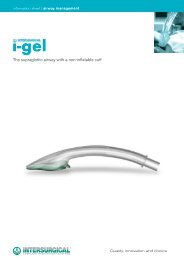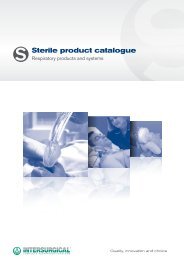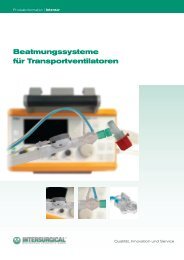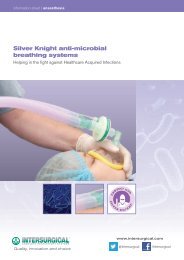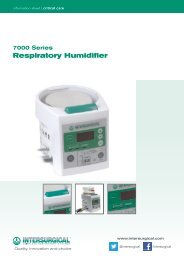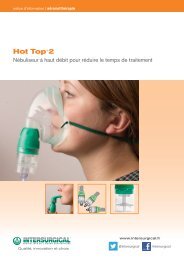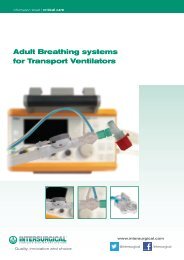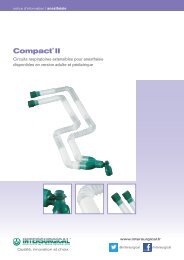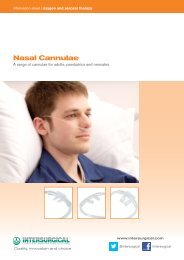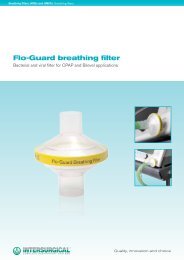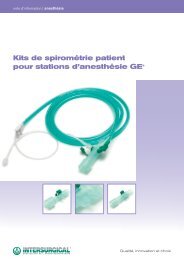Statement concerning the compatibility of the Intersurgical nFlow ...
Statement concerning the compatibility of the Intersurgical nFlow ...
Statement concerning the compatibility of the Intersurgical nFlow ...
You also want an ePaper? Increase the reach of your titles
YUMPU automatically turns print PDFs into web optimized ePapers that Google loves.
An assessment <strong>of</strong> <strong>the</strong> effectiveness <strong>of</strong> anti-microbial breathing system tubing against a<br />
range <strong>of</strong> micro-organisms<br />
Introduction<br />
Infection control is a major area <strong>of</strong> concern in every<br />
hospital. Numerous guidelines are set out to try and<br />
protect both patients and staff from Hospital Acquired<br />
Infections (HAI). It is believed that nine percent <strong>of</strong><br />
hospital in-patients suffer an infection following <strong>the</strong>ir<br />
admission to hospital. 1,2 These infections can vary from<br />
minor to life threatening and all pose numerous<br />
additional burdens on <strong>the</strong> hospital including a financial<br />
one. A recent study into <strong>the</strong> socio-economic burden <strong>of</strong><br />
HAI suggested that an additional £3.6 million was<br />
required for one health care trust to meet <strong>the</strong> care <strong>of</strong><br />
patients with Hospital Acquired Infections. 3<br />
Whilst every hospital does what it can to reduce <strong>the</strong> risk<br />
<strong>of</strong> HAI a large body <strong>of</strong> clinical evidence links levels <strong>of</strong><br />
environmental hygiene and hand transmission <strong>of</strong> microorganisms<br />
as major factors in causing HAI 4,5,6,7<br />
Reducing <strong>the</strong> numbers <strong>of</strong> micro-organisms in <strong>the</strong><br />
environment may help reduce <strong>the</strong> risk <strong>of</strong> cross infection.<br />
This can be achieved in a number <strong>of</strong> ways and various<br />
different material additives have been developed that<br />
can be incorporated into everyday items to reduce levels<br />
<strong>of</strong> microbial contamination. In <strong>the</strong> medical field, work has<br />
been carried out investigating <strong>the</strong> effectiveness <strong>of</strong> such<br />
additives in venous and urinary ca<strong>the</strong>ters as well as<br />
o<strong>the</strong>r implants.<br />
The <strong>Intersurgical</strong> Silver Knight range has an antimicrobial<br />
additive in <strong>the</strong> breathing system tubing that<br />
uses silver ions to disrupt <strong>the</strong> normal enzymatic activities<br />
<strong>of</strong> microbes preventing <strong>the</strong>ir proliferation.<br />
In this study a specified level <strong>of</strong> a silver ion anti-microbial<br />
additive was introduced during production <strong>of</strong> low-density<br />
polyethylene tubing. The potential for microbial growth<br />
on this anti-microbial tubing was <strong>the</strong>n compared to<br />
standard product using <strong>the</strong> protocol outlined and test<br />
organisms outlined below.<br />
Test organisms<br />
The Nosocomial Infection National Surveillance Service<br />
(NINSS) report on <strong>the</strong> Surveillance <strong>of</strong> Hospital Acquired<br />
Bacteraemia 8 indicates that <strong>the</strong>re are a number <strong>of</strong> microorganisms<br />
which contribute to <strong>the</strong> majority <strong>of</strong> Hospital<br />
Acquired Infections. The following range <strong>of</strong> organisms<br />
were evaluated to establish <strong>the</strong> extent <strong>of</strong> effectiveness <strong>of</strong><br />
<strong>the</strong> anti-microbial tubing:<br />
• Methicillin Resistant Staphylococcus Aureus<br />
(KB-1005)<br />
• Staphyloccus epidermis (NBRC-12689)<br />
• Pseudomonas aeruginosa (IFO-13277)<br />
• Klebsiella pneumoniae (NBRC-13889)<br />
• Acinetobacter calcoaceticus (IFO-13006)<br />
• Escherichia coli<br />
Method<br />
Preparation <strong>of</strong> Bacterial Inoculum Nutrient broth was<br />
diluted 500 times and adjusted to pH 7. This 1/500<br />
nutrient broth media was transplanted with <strong>the</strong> bacterial<br />
strain and used as <strong>the</strong> inoculum.<br />
Preparation <strong>of</strong> Test Samples<br />
Samples <strong>of</strong> 50 mm tube cut from <strong>the</strong> product. All surfaces<br />
<strong>of</strong> <strong>the</strong> test pieces were cleaned with gauze containing<br />
ethanol and allowed to dry.<br />
Procedure<br />
Each test piece was placed in sterilised petri dishes and<br />
0.5 ml <strong>of</strong> <strong>the</strong> inoculum (containing >1.0 x 105 colonies)<br />
was dropped onto <strong>the</strong> surface <strong>of</strong> <strong>the</strong> test piece. The<br />
sample was <strong>the</strong>n covered with <strong>the</strong> lid <strong>of</strong> <strong>the</strong> petri dish and<br />
incubated at 35 ±1°C and RH 90% or higher for <strong>the</strong> test<br />
period.<br />
A test control and a control breathing system containing<br />
no anti-microbial additive were run in duplicate to ensure<br />
strain viability and test consistency.<br />
Measurement <strong>of</strong> viable cells<br />
At <strong>the</strong> end <strong>of</strong> <strong>the</strong> test time <strong>the</strong> inoculum was washed <strong>of</strong>f<br />
<strong>the</strong> samples with 10ml <strong>of</strong> diluent. Following serial dilution<br />
on to Tryptone Soya Agar and incubation at 35 ±1 °C for<br />
40-48 hours <strong>the</strong> remaining viable cells were counted and<br />
<strong>the</strong> log reduction in growth established.<br />
E.Coli Method<br />
Silver Knight breathing systems (2025/2026) underwent 7<br />
day simulated use conditioning. Samples were <strong>the</strong>n taken<br />
and placed in individual sterile petri dishes. Antibacterial<br />
activity was determined using <strong>the</strong> method outlined in ISO<br />
22196:2007.<br />
Results<br />
The anti-microbial breathing systems exhibited a 99.9%<br />
reduction in viable organisms as compared to <strong>the</strong> control<br />
tubing after 24hrs. The anti-microbial effectiveness <strong>of</strong> <strong>the</strong><br />
breathing systems was undiminished following 168hrs<br />
incubation (See Figure 1 overleaf).<br />
E.coli results<br />
Reduction compared to <strong>the</strong> initial population after<br />
24hours was ≥ 99.99%<br />
Conclusion<br />
The addition <strong>of</strong> <strong>the</strong> silver ion anti-microbial additive to<br />
<strong>Intersurgical</strong> breathing system tubing greatly reduces <strong>the</strong><br />
viable microbial count level over time. The tubing has<br />
demonstrated a long lasting anti-microbial effect against a<br />
broad range <strong>of</strong> micro-organisms responsible for Hospital<br />
Acquired Infections
Fig. 1 The Effectiveness <strong>of</strong> anti-microbial breathing system tubing versus a range <strong>of</strong> micro-organisms 9<br />
CFU<br />
10000000<br />
1000000<br />
References<br />
100000<br />
10000<br />
1000<br />
100<br />
10<br />
1<br />
Day 0 Day 1 Day 7<br />
P.aeruginosa Standard Tube<br />
P.aeruginosa Silver Knight<br />
K.pneumoniae Standard Tube<br />
K.pneumoniae Silver Knight<br />
S.epidermis Standard Tube<br />
St. epidermis Silver Knight<br />
Acinetobacter sp. Standard Tube<br />
Acinetobacter sp.<br />
Silver Knight<br />
MRSA Standard Tube<br />
MRSA Silver Knight<br />
E.coli Standard Tube<br />
E.coli Silver Knight<br />
1. Meers PD, Ayliffe GA, Emmerson AM, Leigh DA, Mayton-White RT, Mackintosh CA, Stronge<br />
JL. Report on <strong>the</strong> national survey <strong>of</strong> infection in hospitals 1980.Journal <strong>of</strong> Hospital Infection<br />
(Supplementary)1981; 2:1 -11.<br />
2. Emmerson AM, Enstone JE, Griffin M, Kelsey MC, Smyth ETM. The second national<br />
prevalence survey <strong>of</strong> infection in hospitals - an overview <strong>of</strong> results. Journal <strong>of</strong> Hospital<br />
Infection 1996; 32:175 -190.<br />
3. Plowman R, Graves N, Griffin M, Roberts JA, Swan AV, Cookson B, Taylor L. The Socioeconomic<br />
Burden <strong>of</strong> Hospital-acquired Infection. London:Public Health Laboratory Service<br />
and The London School <strong>of</strong> Hygiene and Tropical Medicine;1999;12<br />
4. Hospital Infection Working Group <strong>of</strong> <strong>the</strong> Department <strong>of</strong> Health & Public Health Laboratory<br />
Service. Hospital Infection Control: Guidance on <strong>the</strong> control <strong>of</strong> infection in hospitals. London<br />
Department <strong>of</strong> Health 1995;84<br />
5. Pearson ML. Hospital Infection Control Practices Advisory Committee. Guideline for<br />
Prevention <strong>of</strong> Intravascular device-related Infections. Infection Control and Hospital<br />
Epidemiology 1996 July;17(7):438 -473<br />
6. Dancer SJ. Mopping up Hospital Infection. Journal <strong>of</strong> Hospital Infection 1999;43: 85 -100.<br />
7. Garner JS, Favero MS. CDC Guideline for Handwashing and Hospital Environmental<br />
Control,1985. Infection Control 1986;7:231 –235<br />
8. NINSS reports on surgical site infection and hospital acquired bacteraemia. Commun Dis Rep<br />
CDR Wkly. 2000 Jun 16;10(24):213, 216.<br />
9. Certified Independent Test Results, 2003, 2004, 2011<br />
Note:<br />
The additive does not completely remove <strong>the</strong> presence <strong>of</strong> all contaminants. It is essential that proper infection control<br />
procedures are followed at all times. The patient should always be protected with an appropriate breathing system filter and <strong>the</strong><br />
breathing system replaced inline with <strong>the</strong> <strong>the</strong>atres clean down procedures<br />
April 2012



